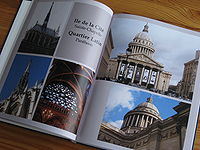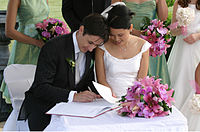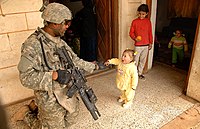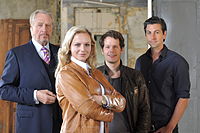Staged photography
Staged photography is the strategic structure of the image message of a photographic recording with a focus on motif and design - before or during the recording. The staging should show elements of the image content in a defined context and arouse certain emotional reactions in the viewer.
The technical effort involved in a photographic staging is often very high, but always only a means to an end. In contrast to, for example, art photography , satellite photography , astrophotography or Lomography , neither the technology used nor the technical parameters of the content are in the foreground. The accuracy of the image content, also in connection with the working method used, is of secondary importance. In contrast to scientific photography , chronophotography or documentary photography , closeness to reality is secondary - what counts is the image message.
The opposite of a photographic staging is the snapshot .
Degree of influence
Staged photography differs according to the degree of influence.
| Name & Degree | Influencing the image motif | Sample actions | Typical examples |
|---|---|---|---|
| Passive staging (lowest degree of staging) |
No change in the image content. Only the view of the subject is changed. | Change the viewing angle and exposure time |
|
| Active Object -Inszenierung (Middle staging degrees) |
Image content is changed. All changed elements are passive (objects). |
Change people and objects, additional lighting |
|
| Active subject -Inszenierung (Highest production degrees) |
Image content is changed. Changed elements can interact (subjects). This interaction is controlled. |
Theatrical gestures of the subjects, "please smile" etc. |
|
The higher degree of staging can contain elements of lower staging.
purpose
Apart from the financial or artistic intentions of the photographer or the client, the staged photography serves one of the two purposes shown in the adjacent illustration. Examples of the “natural” purpose can be found in portrait and food photography . A pure “art” product should be presented in fashion photography or the rainbow press.
post processing
The strategy of a photographic staging also includes the planning of post-processing. One of the following variants is preferred:
- The complete waiver of technically unnecessary work. The publication of this fact gives the production the character of a unique piece . A typical example is large format photography on Polaroid material .
- Image processing techniques that do not change the core message of the staging. A typical example is beauty retouching .
- The rework is part of the strategy through work techniques such as image montage . However, one can only speak of staged photography if the recordings were made with this in mind. A typical example is automobile advertising photography.
Examples
Passive staging
A hotel in the middle of a commercial area (photo taken with a telephoto lens from a great distance).
Even with this image section, many details of the environment are no longer visible: hardware stores, furniture stores, high-voltage lines, hustle and bustle and a lot of traffic.With a location closer to the building and a shorter focal length , the commercial environment is hidden
... and the image already makes a calmer impression.From an even closer location and photographed with a wide-angle lens , the scene almost looks like in a park.
Active subject staging, example: Hitler
A typical example is the Nazi propaganda during the Nazi dictatorship. Images have been arranged very carefully to evoke desired emotions. Since Hitler looks a bit “grumpy” in many of the photos, the picture should be arranged in such a way that it still creates a pleasant overall impression. In the example opposite, a light telephoto lens was used, which makes the main character appear sharp in the golden ratio , the surroundings are slightly blurred, but remain recognizable. The two light points, lamp and back of the chair, form a diagonal, which creates depth in the picture. Objects on the table are loosely arranged, the plant creates a pleasant atmosphere that was seldom found in study at the time . Hitler sits loosely on the table, a rather unusual staging that is also supposed to represent looseness. The " olle Fritz " in the background is certainly not included in the picture by chance . Strong side light from the right creates conciseness , which is still used today in male portraits. Illumination by headlights from the top right and left prevents excessive shadows .
Active subject staging, example: Lenin
There are two pictures of Lenin that are often used as examples of politically motivated photo manipulation . While Leon Trotsky , a friend and companion of Lenin, can still be seen in the first picture , he was later removed by adding an additional wooden wall, because after the death of Lenin, Trotsky fell out of favor under Stalin.
Even if the quality of the recordings is comparatively poor, one recognizes a staging. The photographer Grigori Petrovich Goldstein stood clearly above the other demonstrators on a hill. Lenin forms a diagonal, the only one next to the red flag in the picture - and thereby becomes even more defining. The height of the photo for the second picture was chosen so that the upper edge of the wooden wall forms a line with the upper edge of the crowd, which makes Lenin stand out from the crowd both optically and through a contrast in brightness. This corresponded more to the desired effect than in the first picture, where Lenin's head does not form such a strong contrast to the building in the background and the line mentioned does not exist.
The asymmetrical picture composition (Lenin looks to the left, the larger picture section is on the right) contradicts the basic rules of picture composition at first glance, but is evidently deliberately designed that way. By “reading direction” from left to right, the viewer is distracted too early and led to the most important thing. This disharmony means that the eye does not look at the image linearly, but rather analyzes the image piece by piece, which increases attention to details.
While Trotsky is still raised to the crowd of demonstrators and thus stands out from the crowd and becomes part of the main motif, Lenin in the second picture is clearly separated from the crowd, which isolates him better as a revolutionary leader. The forgery not only removed the unpleasant Trotsky, but also better staged Lenin.
Further
literature
- Lars Blunck (ed.): The photographic reality. Staging, fiction, narration . transcript, Bielefeld 2010.
- Christine Walter: Pictures tell !. Positions in Staged Photography: Eileen Cowin, Jeff Wall, Cindy Sherman, Anna Gaskell, Sharon Lockhart, Tracey Moffatt, Sam Taylor-Wood. VDG, Weimar 2002, ISBN 3-89739-282-8
- Klaus Krüger, Leena Crasemann, Matthias Weiß (eds.): Re-staged photography . Wilhelm Fink, Munich 2010.
- Fritz Franz Vogel: The Cindy Shermans: staged identities. Photo stories from 1840 to 2005 . Böhlau, Cologne / Weimar / Vienna 2006.
Remarks
- ↑ Examples of food photography
- ↑ Klaus Waschik, Where is Trotsky? Soviet image policy as a control of memory in the 1930s , in: Gerhard Paul (Ed.), Das Jahrhundert der Bilder, Vol. 1: 1900–1949 , special edition for the Federal Agency for Civic Education, Bonn 2009, pp. 252–259; Tobias Kruse : Erased comrades , fluter , November 12, 2014 with Goldstein's original and the retouched photo without Trotsky, accessed on April 5, 2017.














